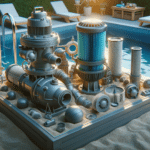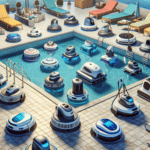Understanding Pool Pumps and Filters
Pool pumps and filters are the heart of any swimming pool’s circulation system. They work in tandem to keep the water clean, clear, and safe for swimmers. The pump’s primary function is to circulate the water, pushing it through the filter where debris and impurities are removed. This continuous cycle ensures that the pool water remains hygienic and visually appealing.
There are various types of pool pumps available, each designed to cater to different pool sizes and usage requirements. Single-speed pumps, for example, operate at one constant speed and are generally more affordable. However, they can be less energy-efficient compared to variable-speed pumps, which allow for adjustable speeds and can lead to significant energy savings over time. Two-speed pumps offer a middle ground, providing both a high and low-speed setting for different needs.
On the other hand, pool filters come in three main types: sand, cartridge, and diatomaceous earth (DE). Sand filters are popular due to their ease of use and affordability. They use specially graded sand to trap particles as water passes through. Cartridge filters, meanwhile, use a pleated fabric to capture debris, offering finer filtration and requiring less water for cleaning. DE filters provide the most thorough filtration, using fossilized remains of diatoms to filter out the smallest particles, but they can be more complex to maintain.
The Role of Pool Filter Sand
Pool filter sand is an essential component of sand filters, which are among the most common types of pool filtration systems. This sand is not just ordinary sand; it is specially graded to trap debris as small as 20 microns. The sand’s rough texture creates a surface that captures particles as the water flows through the filter, effectively removing contaminants from the pool water.
Over time, the sand in the filter can become clogged with debris, reducing its effectiveness. It’s generally recommended to replace the sand every 3 to 5 years, depending on usage and maintenance. When replacing the sand, it’s important to use only sand specifically designed for pool filters, as other types of sand may not have the right size or texture for effective filtration.
Maintaining the sand filter involves regular backwashing, a process that reverses the flow of water through the filter to flush out trapped debris. This helps to maintain the efficiency of the filter and prolong the life of the sand. Additionally, ensuring the correct water flow rate is crucial, as too high a rate can lead to sand being washed away, while too low a rate can result in inadequate filtration.
Choosing the right pool filter sand and maintaining it properly can greatly enhance the effectiveness of your pool’s filtration system, ensuring crystal clear water for swimmers to enjoy.
Setting Up Your Pool Equipment
Setting up pool equipment is a critical step in ensuring efficient water circulation and filtration. A well-planned setup not only improves water quality but also enhances the longevity of the equipment. The process begins with selecting the right location for the pump and filter, ideally close to the pool but protected from direct exposure to the elements.
When installing the pump, it’s important to ensure that it is level and stable. This prevents vibrations and noise during operation. The pump should be connected to the pool’s plumbing system with durable, leak-proof fittings. Regular inspection of these connections is vital to prevent leaks that can lead to water loss and reduced efficiency.
For the filter, the setup involves connecting it to the pump and ensuring that it is securely mounted. The filter’s pressure gauge should be monitored regularly to assess its performance. A significant increase in pressure indicates that the filter needs cleaning or backwashing. Additionally, it’s essential to follow the manufacturer’s guidelines for maintaining the filter media, whether it’s sand, cartridges, or DE.
Finally, integrating a timer with your pool equipment can optimize energy use by allowing the pump to operate during off-peak hours. This not only reduces energy costs but also ensures consistent water circulation, keeping the pool water clean and inviting.
By carefully planning and maintaining your pool equipment setup, you can enjoy a sparkling clean pool with minimal hassle.


